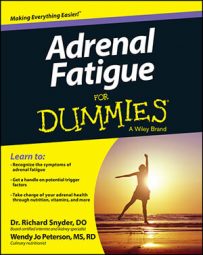Exercise is beneficial for adrenal fatigue patients because it relieves stress, helps build endurance and strength, and can make you feel better all around. One of the most common complaints is that people don't have time to work out. They work all day and they're too tired to exercise at home. One option is to build exercise into and around your workday.
Active transportation
One of the easiest ways to work exercise into your day is to forgo the elevator and other machines that get you from here to there.
Bicycle or walk to and from work
How do you get to work in the morning? Maybe you drive, take a bus, or take the train. If your work is close, consider bicycling to work. If you live in the city, where there's heavy traffic, you may actually get to work faster than you would driving a car. If you take a bus or train, consider getting off at an earlier stop and walking to work.
Don't forget to put on your sneakers before walking to or from work. Using proper footwear is important, especially if you're going to embark on a walking program.
Take the stairs
When you're at work, avoid using the elevator and take the stairs instead. An average sized person can burn about 8 calories walking up a flight of stairs. Contrast this to taking an elevator, in which you burn only about 2 calories (maybe 3 if you pace back and forth in the elevator!).
What goes up must come down! You actually burn a similar number of calories walking down the stairs as you do walking up. You also increase your body's metabolism, which means that throughout the course of the day, you burn calories more efficiently.
Move during the day
Your body was made for movement. Any movement that you can get is going to be positively beneficial. Here are some ways you can increase your fitness level while at work.
Work your glutes and quads
If you were to ask an average person how many times he or she uses the bathroom each day, the answer would probably be six to eight times. If you were to ask how often he or she exercises during those times, the answer would likely be none.
Get some exercise by using the bathroom. How? Simply avoid sitting on the toilet seat. Squatting not only builds up your quadriceps muscles but also strengthens your gluteus maximus muscles in the process. Think of this quality time as a way to perform isometric exercises.
Also note that while sitting at your desk, you can tighten and relax various muscle groups, so you can get exercise benefits even while you're sitting. Start holding each muscle group for a count of five, and then release. At a minimum, you should aim to do this twice for each muscle group during the workday: once in the morning and once after lunch.
Get up and move every hour
If your job is sitting at a desk for 8 to 10 hours a day, you should get up at least once an hour if possible. That's what research studies show. Your body was meant to move. Get up, walk around, and stretch your muscles for a few minutes.
A study in the medical journal Diabetes Care (published in 2011) demonstrated that the less time you spend sitting at your desk, the better your overall health. In particular, there's a decrease in waist size, decrease in body mass index (high BMI correlates with obesity), and a reduction in triglyceride levels. There's a decrease in glucose levels as well.
Walk at lunchtime
Bring a pair of sneakers to work, and you can walk at lunchtime. This is already commonplace in communities where the weather is relatively good and the corporate culture encourages it (Silicon Valley, for example). In some workplaces, you'll see many a co-worker at lunchtime walking around the parking lots or using the walkways between buildings.
Any walking is better than not walking at all. Even if all you can do is walk 15 minutes, your health will improve, your stress levels will lower, and you'll be in a better mood to start the afternoon.
Exercise on the way home from work
After a long workday (especially if you've been sitting behind a desk for 8 hours), exercising in a gym can be just what the doctor ordered. Stop on the way home and just do it.
The benefits of a gym membership are many. In addition to using the free weights and machines, you can take exercise classes, including aerobics and karate. And exercising in a group can be a great motivating experience.
Many companies are starting to recognize that a healthy and fit employee is a productive employee. Some companies arrange for reduced prices at local fitness centers to encourage their employees to use the facilities. A few have free fitness centers on campus. Check with your human resources department to find out whether your company can get you a discount.
Some insurance plans reduce or refund part of your health insurance premiums (or don't increase them) if you maintain a consistent exercise program. The plan may require that you exercise at the gym a few times a week or walk a certain distance every day. Check your insurance plan to see whether there's a deal that applies to you.

